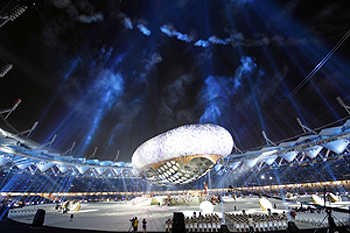 | « Back to article | Print this article |
Spotting the Incredible in India
Bharat Bala, the filmmaker best known for his chic ad campaigns showcasing India like Incredible India, School Chale Hum and Vande Mataram, and now the opening ceremony of the Commonwealth Games 2010, is in New Delhi.
As creative director of the Games ceremonies, his head would have been on the block had something gone wrong during the opening ceremony on October 3.
It not only went off without a glitch, but even repaired some of the damage done by the Organising Committee's lack of organisation and alleged corruption.
But his work is not over. Rehearsals for the closing ceremony of the 11-day sporting extravaganza are on.
Despite the flurry of activities that surround him in the background you hear strains of Vande Mataram, Bala seems relaxed.
He cracks an occasional joke and is courteous enough to thank someone who has handed him some papers. He doesn't bark directions to his driver who has taken him from his hotel to the venue and at the end of our conversation insists that we mention that credit for the opening ceremony goes to a "much larger team," including those from the "Organising Committee and the production people."
'The idea was to inspire India by the things that we see around us'
The biggest challenge before me was to present 5,000 years of Indian history and culture in one hour.
During the initial stages, we had a core team of members, including (Bollywood lyricists) Javed Akhtar and Prasoon Joshi, (film director) Shyam Benegal and me.
We pushed for workshops where we got young Indian and international minds and people from different performing arts who shared their ideas of what kind of story we needed to tell and how we needed to define India.
At the end of these brainstorming sessions, we got many interesting points of view, some of which we integrated into the ceremony.
At all times, the idea was to inspire India by the things that we see around us rather than worry about the West's perception of our country and at the same time make it look spectacular.
We were clear that it wouldn't just be a ground-based show. We wanted to use the space around us and create a vertical installation, which would make it stand out. That was what made the opening of the Beijing Olympics so brilliant.
This is where Mark Fisher of Stufish came into the picture. He was the consultant production designer and the aerostat was his idea.
'Present a tradition of an ancient civilisation that is buzzing and continues to thrive'
I find putting up a show like this similar to making a film because beneath all the technical wizardry you require a strong narrative many tools used to create them (lights, sound etc) are similar and you use them to try and wow the audience.
That would perhaps explain why China hired filmmaker Zhang Yimou (House of Flying Daggers) as the creative director for the opening ceremony of the Beijing Olympics and the London Olympics hired Danny Boyle (Slumdog Millionaire).
The essence of the CWG opening ceremony was what a contemporary mind could do to present a tradition of an ancient civilisation that is buzzing and continues to thrive.
Keshava, the child prodigy who played the tabla alongside hundreds of drummers, represented just this.
Through him we saw that GenNext was indeed ready to be part of this continuum.
'God lives in India'
We got the stadium quite late and the last month saw so much rain that there was time just for a little over two-and-a-half rehearsals.
In fact, we didn't have a single dress rehearsal and some segments like the Dandi March sand art one (when many artists simultaneously etched images of Mahatma Gandhi in sand) was practically done live.
The motif that emerged between the aerostat and the sand artists wasn't thoroughly tested since we didn't have the time.
Having gone though this process, I often feel that God lives in India.
The efforts of so many people coming together are overwhelming.
We started 17 months ago and worked independent of the issues and controversies surrounding the Games.
One of my biggest personal learnings is that you need to work with an open mind.
If you need to go back to the drawing board, you should, and chances are that the final product will come out looking much better.
'These are nothing but good nation-building ideas'
At the same time, we knew that to make this successful, we shouldn't be looking at what Athens, Doha or China did and instead create something we can relate to and be proud of.
Today we are looking forward to the closing ceremony. I am asked if Bollywood will be a part of it and all I can say that though there will be something, the ceremony will stand by itself and not because of Bollywood's presence.
You can expect traditional martial arts, Sufi and a lot of other elements that will make the closing ceremony a far different affair.
The exercise of putting up a show such as this has proven to be a major learning curve for everyone associated with it.
It is easy to criticise the bureaucracy from the outside, but when you work within it you begin to see things differently.
Things take time because there are many agencies and far too many people involved. Yet everyone was assertive on putting up a good opening ceremony and was just a phone call away.
Having been through this experience and the learning curve, I feel things will only get better now.
One of the things that I feel comes out of my work is that one constantly needs to push one's imagination, inspire people, make them feel good and give them a reason to be part of this country.
These are nothing but good nation-building ideas.




